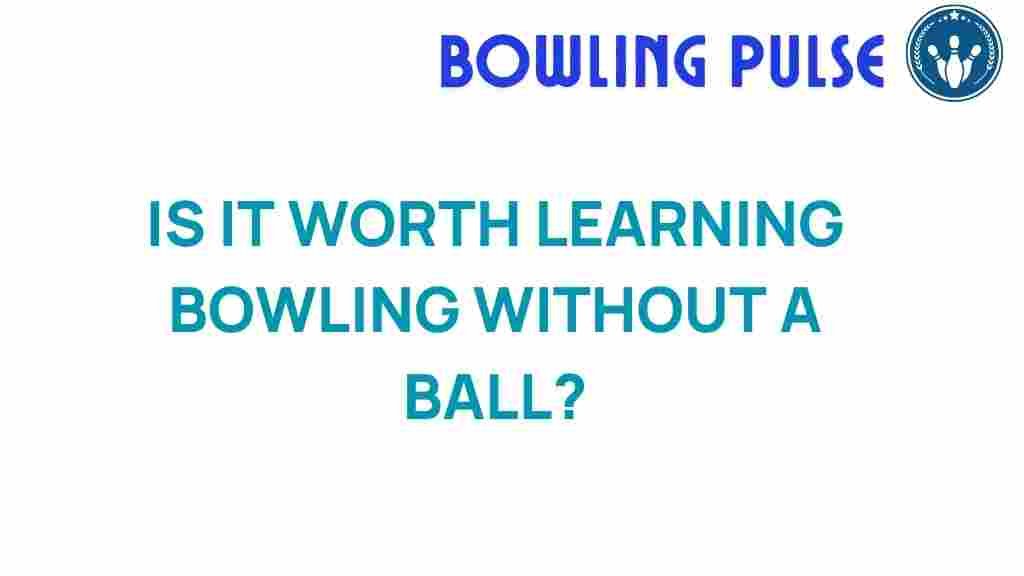Can You Master Bowling Without a Ball?
Bowling is a sport that combines physical skill with mental strategy, making it a favorite pastime for many. While most people believe that you need a ball to improve your game, the surprising truth is that you can actually enhance your bowling technique and skills without one. This article will delve into the various aspects of bowling, including practice methods, the mental game, and fundamental training techniques that can lead to significant improvement. By focusing on the right strategies, you can master bowling even without stepping onto the lanes with a ball.
The Importance of Technique in Bowling
Technique is crucial in bowling. The way you approach the lane, your stance, your arm swing, and your release all play vital roles in determining your performance. Here are some key elements of bowling technique that you can practice without a ball:
- Stance: Work on your beginning stance. Stand as if you are about to bowl, ensuring your feet are shoulder-width apart and your knees are slightly bent.
- Approach: Practice your walking approach. Focus on your footwork and how you shift your weight from one foot to the other.
- Arm Swing: Without a ball, you can practice your arm swing. Make sure your arm moves smoothly and straight, mimicking the motion you would use with a ball.
- Follow Through: The follow-through is essential in bowling. Practice extending your arm after the imaginary release, maintaining balance and form.
Enhancing Your Bowling Skills
While physical practice is essential, you can also improve your bowling skills through mental exercises. Here are some effective strategies:
- Visualization: Close your eyes and visualize yourself bowling. Imagine every detail, from your approach to the ball hitting the pins.
- Mental Rehearsal: Mentally rehearse each aspect of your game. Picture overcoming challenges, such as difficult splits or strikes.
- Study Professionals: Watch professional bowlers. Analyze their techniques and strategies, and try to incorporate some of their skills into your mental practice.
Developing the Mental Game
The mental game in bowling is just as important as the physical aspects. Mastering your mindset can lead to better performance. Here are some tips to improve your mental game:
- Focus: Develop your ability to concentrate. This can be done through meditation or mindfulness exercises.
- Positive Self-Talk: Use positive affirmations to build your confidence. Remind yourself of your strengths and past successes in bowling.
- Set Goals: Establish specific, measurable goals for your practice sessions. This helps to keep you focused and motivated.
Practicing Bowling Fundamentals
Even without a ball, you can practice the fundamentals of bowling. Here’s how to focus on the basics:
- Grip: Familiarize yourself with the proper grip. You can practice hand positions and finger placements, ensuring that you feel comfortable when you do have a ball in your hand.
- Body Alignment: Work on your body alignment. Stand in front of a mirror, ensuring your shoulders, hips, and feet are aligned correctly.
- Timing: Practice your timing by counting your steps and movements as you approach the imaginary lane.
Strategies for Improvement
Improvement in bowling requires a strategic approach. Here are some strategies to consider:
- Record Your Progress: Keep a journal of your practice sessions. Document what you worked on and how you felt, which will help you identify areas for improvement.
- Find a Mentor: If possible, find a more experienced bowler who can provide feedback and guidance.
- Join a League: Engaging with others who share your passion for bowling can provide motivation and accountability.
Step-by-Step Process to Practice Bowling Without a Ball
Here’s a simple step-by-step process you can follow to master bowling techniques without using a ball:
- Warm-Up: Start with a light warm-up to loosen your muscles. This can include stretching your arms, legs, and back.
- Practice Stance: Spend a few minutes getting comfortable in your bowling stance.
- Footwork Drills: Practice your approach by walking in your bowling shoes. Focus on your steps and timing.
- Arm Swing Exercises: Mimic the arm swing motion. Focus on keeping your elbow straight and your hand relaxed.
- Follow-Through Practice: Finish your motion with a strong follow-through. Practice this in front of a mirror.
- Mental Visualization: After your physical practice, take time to visualize your perfect game.
- Cooldown: Conclude your practice with some light stretching to prevent injury.
Troubleshooting Common Issues
Even without a ball, you might encounter challenges while practicing. Here are some common issues and how to troubleshoot them:
- Loss of Balance: If you find yourself losing balance, focus on your follow-through and ensure your body is aligned correctly.
- Inconsistent Arm Swing: Pay attention to your arm motion. Practicing in front of a mirror can help you identify inconsistencies.
- Poor Mental Focus: If your mind wanders, try incorporating short meditation sessions to build your concentration.
Conclusion
In conclusion, mastering bowling without a ball is not only possible but can also be incredibly beneficial. By focusing on your technique, honing your mental game, and practicing the fundamentals, you can significantly improve your skills. The key is consistency and dedication to your training. With the right approach, you can become a better bowler, ready to hit the lanes with confidence.
For more information on improving your bowling skills, check out this helpful resource. Remember, every great bowler started with the fundamentals, so take your time, and enjoy the process of improvement!
If you want to engage with others in the bowling community, consider joining a local league or club. This experience can provide valuable insights and further enhance your skills.
Now that you understand how to master bowling without a ball, it’s time to get started on your journey to improvement!
This article is in the category Techniques and created by BowlingPulse Team
